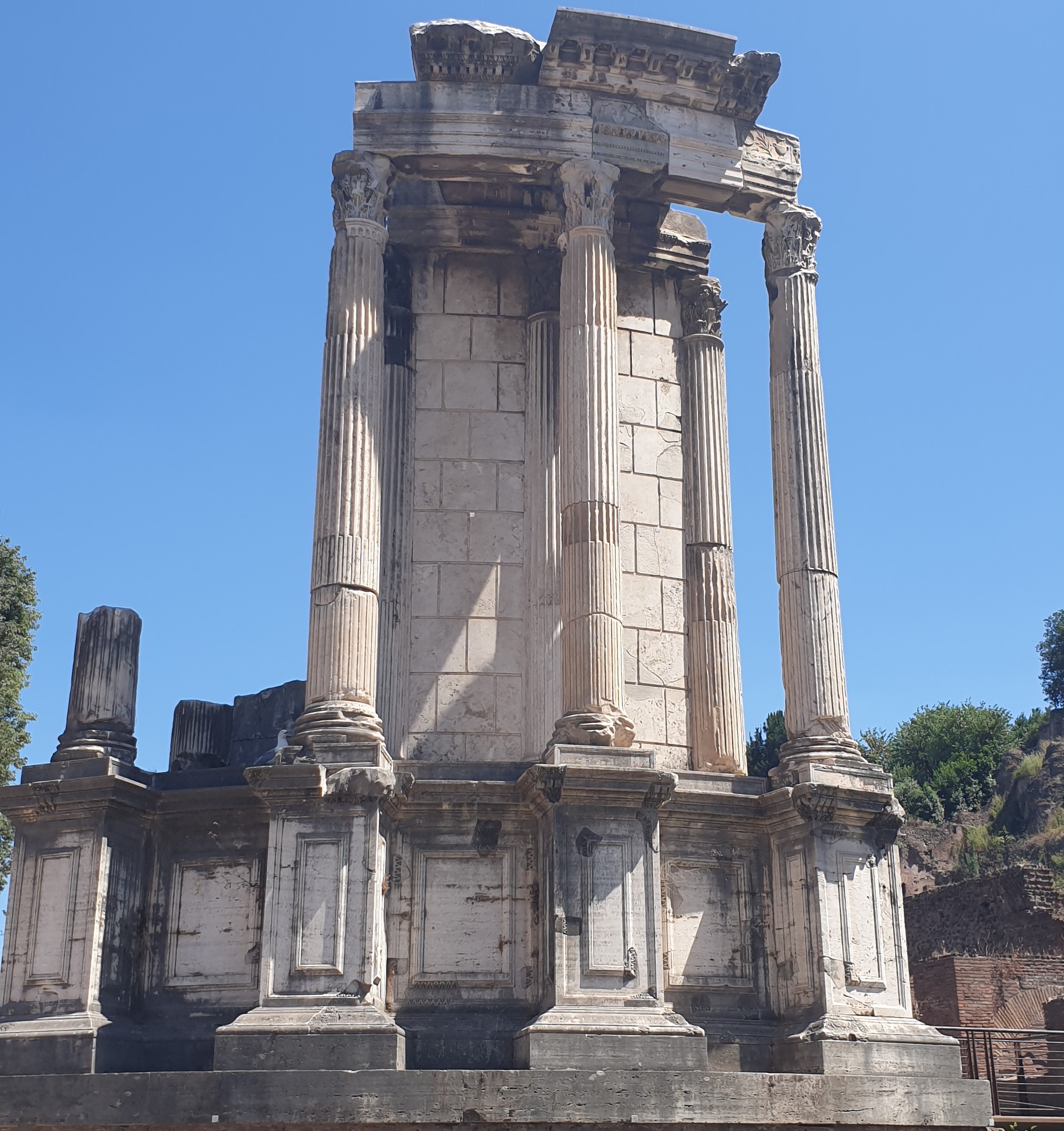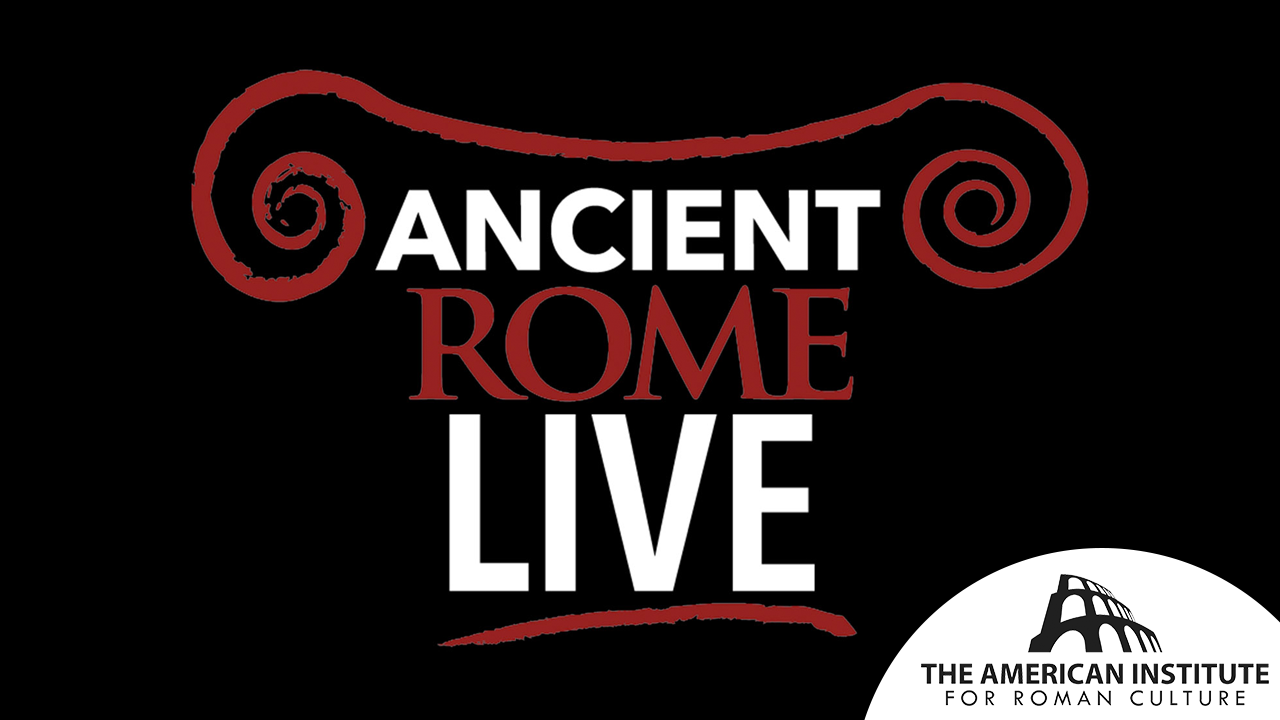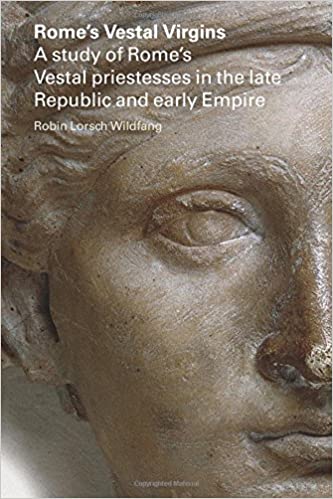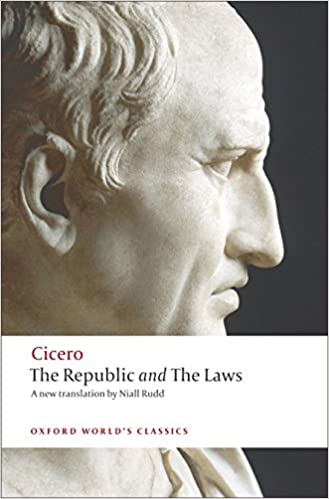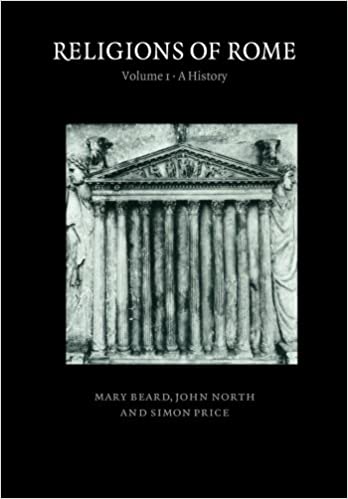Start with our video overview:
The house of the Vestal Virgins is one of the most famous sites in the Roman Forum area. Six Vestals cared for the sacred flame of the Temple of Vesta and many other sacred duties, for 30 years of service, under the guidance of the Pontifex Maximus.
Explore further:
VESTA, AEDES, the temple of Vesta at the east end of the forum, near the fountain of Juturna and the temple of Castor (Dionys. ii. 66; vi. 13; Mart. i. 70. 3-4; Hor. Sat. i. 9), originally within the precinct of the Vestals (ATRIUM VESTAE, q.v.; Van Deman, Atrium Vestae, 9-11).
Read more:
The building of this shrine was ascribed by some to Romulus, but wrongly according to the Roman antiquarians, who attributed it to Numa (Dionys. ii. 65-66; Fest. 262; Plut. Numa ii). It was, however, outside the Palatine pomerium, and cannot have antedated the second stage of the city’s growth. It was a round, tholus-shaped, structure (Ov. Fast. vi. 265-282; Fest. Plut. locc. citt.), probably in imitation of the ancient Italic hut (Altm. 14), and said to have been built originally of wattles with a thatched roof (Ov. Fast. vi. 261-262). It was not an inaugurated templum (Gell. xiv. 7. 7; Serv. Aen. vii. 153: non augurio consecratum ne illuc conveniret senatus), although it was sometimes called templum by the poets (e.g. Ov. Fast. vi. 265, 281). It contained the sacred fire (Ov. Fast. vi. 297; see PORTA STERCORARIA), the Palladium brought by Aeneas from Troy (Ov. Trist. iii. I. 29; Dionys. ii. 66), and other sacra (Dionys. loc. cit.), which were kept in a secret recess called the penus Vestae (Fest. 250: penus vocatur intumus in aede Vestae tegetibusSaeptus; Serv. Aen. iii. 12; cf. Fest. 158, 161; Altm. 59-60), but no statue of the goddess herself (Ov. Fast. vi. 295-298; see AEDICULA VESTAE, S. ATRIUM VESTAE, ad fin.).
This temple was undoubtedly burned when the Gauls sacked the city in 390 B.C. (Liv. v. 42; Plut. Cam. 21), and again in 241 when Caecilius Metellus rescued the Palladium at the cost of his sight, which was miraculously restored (Liv. ep. 19; Oros. iv. ii. 9; Ov. Fast. vi. 437-454; Dionys. ii. 66; Plin. NH vii. 141; Val. Max. i. 4. 5). In 210 it was saved from burning by the devotion of thirteen slaves (Liv. xxvi. 27), and again in 14 it was threatened and the sacra removed (Cass. Dio liv. 24). In the great fire of 64 A.D. it was burned, but soon restored, probably by Nero (Tac. Ann. xv. 41; Hist. i. 43; cf. Cohen, Nero, n. 334, 335; BM. Nero ioi-io6; cf. Introd. clxxv), and later in 191 (Herod. i. 14. 4: Cass. Dio lxxii. 24), when it was restored by Julia Domna, the wife of Septimius Severus. It is mentioned in the Regionary Catalogue (Reg. VIII), and was closed by Theodosius in 394.
This temple is represented on coins dating from the end of the republic (gens Cassia 60 B.C., Babelon i. 333, Nos. 8, 9; BM. Rep. i. 482. 3781-5) to the restoration by Julia Domna (see a discussion of all these coins 1 by Dressel, Zeitschrift f. Numismatik, 1900, 20-31; Mitt. 1892, 284-287; 1893, 285-286), and on fragmentary reliefs-one in the Uffizi at Florence (catalogue No. 325; NS 1883, pi. xix. b; DS fig. 2944, and freq.), another in the Lateran in the fifteenth century, now lost, but known from a drawing in the Destailleur collection (M61. 1891, 136),2 and a third formerly in the Villa Negroni, copied by Winckelmann, and now lost (NS 1883, pl. xix. a).
The excavations of 1883 and 1899-1900 brought to light various architectural fragments and the podium (NS 1883, 434-468; 1900, 159-191; NA Aug. 1900, 437-456; BC 1900, 281-284; 1903, 57-69; CR 1899, 185; 1901, 139; Mitt. 1902, 88-92; Atti 525-530; for discoveries in 1549, see LS ii. 203). This podium consists of four strata of concrete with facings of opus incertum and brick. The lowest stratum is a circular foundation set in the soil, 15.05 metres in diameter and 2.17 thick. On this rest the three others. On the east side and here and there on the other sides of these strata are tufa blocks which were the foundation of the marble steps. Almost in the centre of this podium is a cavity of trapezoidal shape, extending to the bottom of the foundation, a depth of 5 metres. The sides measure between 2.30 and 2.50 metres in length. This cavity, or favissa, was entered from the floor of the cella, and may have been the receptacle of the stercus (Fest. 344; AA 1899, 3) or ashes of the sacred fire which were removed once a year and emptied out of the porta Stercoraria. Most of this foundation and podium dates from Augustus (AJA 1912, 393), but the favissa belongs to the early part of the principate of Domitian (ib. 413), and the highest stratum to the time of Septimius Severus (ib. 426).
The coins of Augustus (Cohen, Aug. 250-25 ), probably struck towards the end of Tiberius’ reign (BM. Tib. 142; cf. Introd. cxxxii, cxxxix; Num. Chron. 1917, 258, for dating), represent a round structure with a conical roof (of bronze, according to Pliny NH xxxiv. 13), standing on a base of three steps, with columns surmounted by Ionic capitals as is also the case on the Florence relief. The existing architectural fragments belong to the final restoration by Julia Domna, and these, together with the coins and reliefs, enable us to restore the temple with some degree of accuracy. The change from Ionic to Corinthian capitals seems to have been made during the first century, probably by the Flavians, but it is not probable that the temple of the third century differed materially from that of the first except in this respect and in the greater height of the podium. It was of white marble, peripteral, with twenty columns connected by metal gratings. The roof was dome-shaped, with an opening in the centre for the exit of smoke of the sacred fire. This opening must have been protected by metal work of some kind, which would allow the entrance of light. There are indications of at least one window in the cella wall. The shafts of the columns were fluted, 0.51 metre in diameter and about 4.45 in height. The door was on a level with the top of the podium, and not approached by steps as on the coins of Augustus.
(For restorations, discussion and literature of this temple, see Jord. i. 2. 293, 421-423; Gilb. i. 301-310; iii. 405-415; Jordan, Der Tempel d. Vesta u. d. Haus d. Vestalinnen, 1886; Auer, Der Tempel d. Vesta u. d. Haus d. Vestalinnen, Denkschrift d. Wiener Akad. 1888, 209-228; Mitt. 1889, 245-247; Altm. 51-60; HC 197-204; Thedenat 83-92, 312-314; Middleton i. 289-299; DR 126-137; RE Suppl. iv. 474-476; Capitolium ii. 219-224; HFP 44-46).
1 Special attention may be called to the restoration of Republican coins by Trajan (Babelon ii. 573, 574, Nos. 11, 12); for coins of Vespasian and Domitian, see NS 1900, 168.
2 Cf. Mitt. 1892, 285. It was also drawn by Giuliano da Sangallo (Barb. 66) and by Dosio (Berol. f. 4, No. io; cf. Mitt. 1893, 286; Ausonia, vii. So). It has often been identifie.l with the Uffizi relief, but wrongly.
This content is brought to you by The American Institute for Roman Culture, a 501(C)3 US Non-Profit Organization.
Please support our mission to aid learning and understanding of ancient Rome through free-to-access content by donating today.
License
Created by The American Institute of Roman Culture, published on 02/21/2021 under the following license: Creative Commons: Attribution-NonCommercial-ShareAlike. This license lets others remix, tweak, and build upon this content non-commercially, as long as they credit the author and license their new creations under the identical terms. Please note that content linked from this page may have different licensing terms.
Cite This Page
Cite this page as: Darius Arya, The American Institute for Roman Culture, “Vesta, Forum (Temple of Vesta)” Ancient Rome Live. Last modified 03/26/2021. https://ancientromelive.org/vesta-forum-temple-of-vesta/

